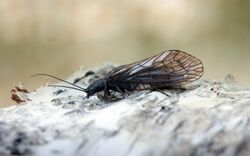Biology:Neuropterida
| Neuropterida | |
|---|---|

| |
| Sialis lutaria (Megaloptera: Sialidae) | |
| Scientific classification | |
| Domain: | Eukaryota |
| Kingdom: | Animalia |
| Phylum: | Arthropoda |
| Class: | Insecta |
| (unranked): | Holometabola |
| Clade: | Aparaglossata |
| Clade: | Neuropteroidea |
| Clade: | Neuropterida |
| Orders | |
| |
| Synonyms | |
|
Neuroptera sensu Palker, 1982 | |
The Neuropterida[1] are a clade, sometimes placed at superorder level, of holometabolous insects with over 5,700 described species, containing the orders Neuroptera (lacewings, antlions), Megaloptera (alderflies, dobsonflies), and Raphidioptera (snakeflies).
Historically, they were known as Neuroptera, but this name nowadays refers to lacewings and their relatives (e.g. antlions) only, which formerly were known as Planipennia. Part of the Holometabola and related to beetles, they can be considered an unranked taxon. Arguably, the Holometabola might be considered an unranked clade instead, and be divided into numerous superorders to signify the close relationships of certain holometabolan groups.[2]
The Mecoptera (scorpionflies) were formerly included here too by some authors, but they actually belong to the Mecopteroidea (or Antliophora), the holometabolan clade containing also true flies and fleas.
Neuropterida are fairly primitive-looking insects, with large wings but weak wing muscles, giving them a clumsy flight. Most are active at dusk or in the night as adults, and the larvae of many are aquatic, living in rivers. At least the larvae, but in many cases the adults too, are predators of small arthropods. Adult neuropteridans range in size from that of a midge to that of a large dragonfly (15 cm (5.9 in) wingspan); the largest species tend to resemble drab, clumsily flying damselflies.
In addition to the three living orders, there is an entirely extinct family of Neuropterida, the monotypic Rafaelidae. These are of an indeterminate but probably rather basal position; thus the single genus Rafaeliana from the Early Cretaceous Santana Formation's Crato Member in Brazil might for the time being be better placed in the Neuropterida directly, without assigning it to an order, until relatives are found and/or its systematic position gets resolved better.[2] The extinct order Glosselytrodea may also be a member or close relative, though classification is unclear.[3]
A phylogenomic analysis published in 2023 confirmed the topology of the neuropterid orders and found the relationships between the families of Neuropterida as shown in the following phylogenetic tree.[4]
| Neuropterida |
| |||||||||||||||||||||||||||||||||||||||||||||||||||||||||||||||||||||||||||||||||||||||||||||||||||||||||||||||||||||||||||||||||||||
References
- ↑ "ITIS & Species 2000 Catalogue of Life Management Hierarchy". Integrated Taxonomic Information System (ITIS). 2017. https://www.itis.gov/servlet/SingleRpt/SingleRpt?search_topic=TSN&search_value=666108#null.
- ↑ 2.0 2.1 Haaramo, Mikko (2008): Mikko's Phylogeny Archive: Neuropterida. Version of 11 March 2008. Retrieved 5 May 2008.
- ↑ Grimaldi, David; Engel, Michael S. (2005). Evolution of the Insects. Cambridge University Press. ISBN 978-1-107-26877-7.
- ↑ Cai, Chen-Yang; Tihelka, Erik; Liu, Xing-YUE; Engel, Michael S. (2023). "Improved modelling of compositional heterogeneity reconciles phylogenomic conflicts among lacewings". Palaeoentomology 6. doi:10.11646/palaeoentomology.6.1.8.
External links
- Oswald, John D. (2023). Neuropterida Species of the World. Lacewing Digital Library, Research Publication No. 1. (an online catalog of the Neuropterida species of the world)
- Oswald, John D. (2023). Bibliography of the Neuropterida. Lacewing Digital Library, Research Publication No. 2. (an online bibliography of the global scientific literature of the Neuropterida)
- Lacewing Digital Library (a web portal that provides access to a suite of online resources that contain data on the superorder Neuropterida)
Wikidata ☰ Q730799 entry
 |










